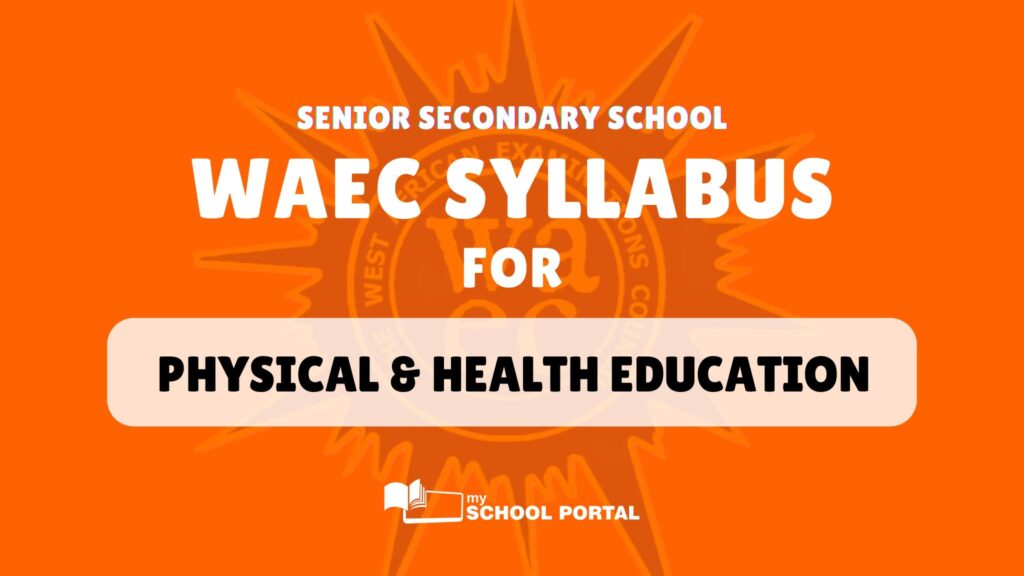The WAEC syllabus for Physical and Health Education examination is drawn from the Senior School Health Education curriculum and directed towards empowering students to have correct, adequate and timely information that will make them acquire attitude and practices which will restore, maintain and promote positive health.
Since Health Education is skill-based and involves knowledge, belief, attitude and practices, evidence of involvement in practical work will be determined through practical test. It is therefore, essential that the examination syllabus is used in conjunction with the Teaching curriculum.
This examination syllabus is designed to assess the extent to which candidates have been able to:
- acquire basic knowledge of the human body and necessary skills for maintenance of health;
- acquire positive health practices in the school and community;
- identify and show the ecological relationship between man and his environment as a basis for preventing diseases;
- make observations and draw inferences from practical experiences that ay have implications for health;
- develop readiness necessary for professional training in health related careers.
The examination is divided into Papers 1, 2, and 3, all of which must be taken. Papers 1 and 2 will be a composite paper to be taken at one sitting.
Paper 1 will consist of fifty multiple choice objective questions, all of which must be taken in 1hour for 50 marks. Paper 2 will consist of two sections, Sections A and B. Section A will consist of six short-structured questions, all of which must be answered for 30 marks. Section B will consist of three essay questions out of which candidates will be required to answer two questions for 40 marks. The paper will last 1 hour. Paper 3 will be a practical test for school candidates and an alternative test of practical work for private candidates. The paper will last for 1¾ hours and carry 80 marks.
Detailed WAEC Syllabus for Physical and Health Education
A. History and development of health education
- Meaning and setting for health Education.
- Meaning
- Setting
- home-based;
- school-based;
- community-based;
- health facility-based;
- work place-based.
- Meaning of health promotion.
B. Human anatomy and physiology
- Cells and tissues of Human Body.
- Types of cell:
- somatic cells;
- sex cells.
- Cell division:
- Mitosis;
- Meiosis
- Cell differentiation:
- Formation of tissues, Organs and Systems.
- Growth and development
2. Sense Organs
- Structure and functions of the following sense organs:
- eye
- ear
- skin
- nose
- tongue
3. Systems of the Body
- Skeletal system and muscles
- The general plan of the axial and appendicular skeleton.
- Functions of the skeletal system.
- Joints: Structures and types.
- Structures and types of muscles tissues.
- Movement.
- Circulatory System
- Structure and functions
- Heart
- Blood and lymph vessels
- Composition of blood and lymph
- Blood and lymph
- circulation
- Process of blood clotting
- Blood groups, rhesus factors hemoglobin, genotype.
- Diseases disorder of the circulatory system and their causes; sickle cell anaemia, leukaemia, haemophilia arteriosclerosis, hypertension, coronary thrombosis and stroke.
- Digestive system
- Organs of the digestive system and their functions.
- Process of digestion
- Absorption, assimilation and metabolism
- Diseases/disorders of the digestive system and their prevention.
- Excretory System
- Process of urine formation.
- Respiratory System
- Process of respiration
- Mechanism of breathing
- Gaseous exchange.
- Tissue/Cellular respiration.
- Diseases/disorders of the respiratory system and their control
- Process of respiration
- Nervous System:
- Structure and functions of the components of the nervous system
- Voluntary and involuntary actions
- Endocrine System:
- Location of the different endocrine glands, the hormones produced and their functions.
- Homeostasis
- Physiological factors affecting homeostatis
4. Posture and Postural Defects.
- Definition
- Characteristics of correct posture
- Determination of correct postures
- Types of postural defects: Flat foot; scoliosis, kyphosis and lordosis
- Effects of incorrect posture on physical appearance, position and functions of body organs
C. Personal health
- Meaning and importance of physical health.
- Personal hygiene
- Promotion and maintenance of health:
- Definition
- Factors and their roles in the maintenance of health
5. Health Screening
- Eye defects and their corrections: Myopia, Hypermetropia, Astigmatism, presbyopia, squints (cross eye).
- Auditory defects
- Conductive impairment
- Neurosensory impairment
- Disorder of the skin
- Care of the eye, ear and skin.
- Dental health education
- Meaning and types
- Types of human teeth
- Teeth diseases
- Dental caries and gingivitis should be mentioned.
D. Community health
- Community health services
- Definition
- Providers
- Orthodox services e.g. primary health care
- Traditional services e.g. bone setters, birth attendance.
- Community efforts in health promotion.
- School health programmed
- Definition
- Components
- Skill-based health education
- Healthful school environment
- School feeding services
- School health and nutrition services
- School, home and community relationship
- Goals and Objectives.
- Linkages for promotion (initiatives)
- Health Promoting School (HPS)
- Child-Friendly School (CFS)
- Focusing resources on Effective Schools Health (FRESH)
- Life Skills (LS) Education for All (EFA)
- Family health
- Meaning
- Maternal and child health
- Family size and budgeting
- Ageing and death education
- Definition and features of the elderly.
- Ways of relating with the elderly.
- Meaning of grief and death. Common causes of death
- Common causes of death.
- Epidemiology and vital statistics
- Definitions
- Components of vital statistics
- Birth rate
- Mortality rate
- Morbidity rate
- Uses of the major components of vital statistics.
E. Environmental health
- Housing
- Criteria for good housing to include siting, ventilation, lighting and sanitation.
- Components of a standard house.
- Water supply
- Definition and sources
- Purification and uses.
- Waste disposal
- Meaning
- Types:
- refuse;
- Sewage. Methods
- Pollution
- Meaning Types: air, water, soil and noise.
- Meaning and sources of pollutants.
- Health consequences of pollution.
- Industrial occupation
- Meaning
- Programmes: Industrial health services
- Occupation hazard
- Pests and vectors control
- Meaning
- Habitats of pests and vectors Harmful effects and control
- Harmful effects and control.
F. Nutrition and food nutrients
- Nutrition
- Classes, sources and functions of food nutrients.
- Caloric value of food nutrients
- Balanced/adequate diets
- Definition
- Classification
- Nutritional problems
- Factors influencing feeding habits/choice of foods
- Water
- Nutritional processes: ingestion, digestion, absorption, assimilation and metabolism and defecation/ejection.
- Beverages
- Definition
- Types and effects
- Diet for different group of people: children, male adolescent; female adolescent; athletes; pregnant woman; adult and aged
- Food hygiene, preservation and storage
- Meaning and Principles of food hygiene
- Effects of methods of food preparation on nutrients.
- Methods of food preservation: Smoking/drying/dehydration, Freezing/refrigeration, addition of chemicals/sugar salts, Bottling/pickling/canning.
G. Safety education and first aid
- First Aid
- Meaning/aims and principles of first aid
- First aid kit
- Specific emergency conditions cuts; Wounds; bleeding dislocation; fractures; burns; scalds; shocks; asphysia/suffocation; poisoning.
- Agencies providing First Aid Services.
- Disaster
- Meaning and types
- Disaster relief activities
- Accident
- Types and causes
- Prevention
- Disability and rehabilitation
- Meaning Types and prevention
H. Drug, alcohol and tobacco
- Drug Education
- Terminologies in drug education
- Classes of drugs commonly abused.
- Ways of taking drugs into the body Drug abuse and consequences of self medication
- Behaviour altering chemicals
- Tobacco
- Components
- Effects of smoking on health.
- Alcohol on health
- Effects of alcohol on health.
- Drugs
- Effects of drug on health
- Tobacco
I. Communicable and non communicable diseases
- Diseases: meaning and classes of diseases.
- Communicable diseases
- Definition
- Classification of communicable diseases
- Air-borne/Respiratory diseases Common cold, measles, whooping cough, poliomyelitis, tuberculosis and cerebro-spinal meningitis, diphtheria.
- Water/food-borne diseases: Dysentery, cholera, typhoid fever and schistosomiasis, guinea worm
- Insect-borne diseases: Malaria, yellow fever, trypanosomiasis and filariasis
- Worm infection:
- Ascarislumbricoides (round worm)
- Taeniasolium (tape worm)
- Ancylostomaduodenale (Hook worm)
- Dracunculusmedinensis (Guinea worm)
- Animal-borne diseases rabies, leptospoirosis
- Contact diseases diseases; Gonorrhoea, syphilis, Tineapedis (athlete/foot),Taeniacapitis (ringworm) leprosy, scabies and Acquired immune Deficiency Syndrome (AIDS)
- Factors necessary for communicable diseases to occur:
- Causative agent
- Susceptible host;
- Transmission route (environment)
- Non-communicable diseases:
- Types
- Deficiency (scurvy, pellagra, rickets, Kwashiorkor, anaemia, beriberi etc)
- Diseases due to growth in cells, heredity and normal disorders (cancer, diabetes, epilepsy, haemophilia, heart disease, hypertension. Ulcer, mental illness, sickle cell, rheumatism, infertility, asthma, albinism etc.
- Types
J. Family life and human sexuality education
- Human Reproduction
- Definition of terms: Reproduction; sex gametes; ovulation; menstruation; fertilization; pregnancy and gestation.
- Structures and functions of male and female reproductive organs.
- Conception, pregnancy, foetal development and child birth
- Diseases disorders of the reproductive system
- Human Sexuality Education
- Meaning and importance
- Life skills (Assertive Negotiation and communication skills)
- Family and family member roles.
- The family – Meaning and types
- Family size
- Family life challenges:widowhood; single parenthood, pre-marital and extra-marital affairs, in-laws etc.
- Agencies promoting healthy family living
- Family planning and safe motherhood.
- Meaning and need for family planning
- Birth control methods
- Safe motherhood
- Population Education
- Meaning of population and population education.
- Census and its problems
- Small and large population
K. Emotional and social health
- Interrelationship
- Attributes
- Definition of personality and personality traits
- Personality problems and solution
- Mental health:
- Definition
- Promotion
- Types and prevention
- Importance
L: Consumer health education
- Consumer health products and services
- Laws protecting the consumer
- Factors influencing choice of consumer products; Authencity; cost; availability; accessibility; availability and advertisement.
- Consumer health care services
- Quacks and quackery meaning and types
- Health insurance and advertisement of health products and services
- Nostrum:
- Definition and types
- Reasons for avoiding nostrum
Recommended Materials
The following materials are required as part of WAEC syllabus for Physical and Health Education
- Models of various organs of the body;
- Models of various parts of the body e.g. tooth;
- Human skeleton;
- Bones of the body;
- Contraceptive devices;
- Reagents for testing of starch, protein, fat;
- Road safety signs;
- Different types of safety elements;
- Posters/charts of systems of the body e.g. reproductive, digestive, excretory;
- First aid box and kits;
- Fire extinguisher;
- Sand bucket;
- Photographs of health facilities and workers e.g. doctors , nurses, dentist at work;
- Photographs of methods of sewage and refuse disposals;
- Microscope
- Stethoscope
- Preserved worms
- Preserved pests and vectors
- Photographs/posters of various types of communicable and non-communicable diseases;
- Model/poster showing parts of the body;
- Materials for personal hygiene e.g. toothpaste, comb, toothbrush;
- Dissecting set
- Photographs/posters of accident scenes;
- Photographs/posters showing methods of food preservation
- Photographs/posters showing disaster scenes;
- Safety;
- Photographs/posters of drugs commonly misused/abused
- Tobacco products;
- Hand lens;
- Real objects/photographs/poster/charts of classes of food;
- Photographs/posters showing correct postures
- Photographs/posters showing postural abnormalities;
- Poster/real object of sphygmomanometer, thermometer, litmus paper snellen chart.
Related
Stay updated with the latest student resources and insights from My School Portal! Subscribe to our newsletter for fresh content delivered straight to your inbox—no spam, just value 😊














